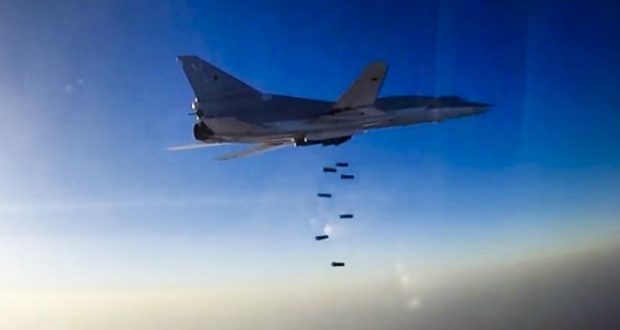Regime forces go deep into the western desert of Deir Ezzor and about 50 km separate them from the besieged city of Deir Ezzor
Russian warplanes bomb hysterically the remaining areas in the countryside of Al-Raqqa and pave the way for the regime forces to advance from a new area into Deir Ezzor
As the regime forces advanced during the last 24 hours in the remaining parts of the eastern countryside of al-Raqqa, near the southern banks of the Euphrates River, and about 72 hours after the regime forces entered Deir Ezzor province for the first time after crossing the administrative border of al-Raqqa with the western countryside of Deir Ezzor, the regime forces managed to go deeper into the western countryside of Deir Ezzor, reducing the distance to about 50 km, between them and the city of Deir Ezzor, which is besieged by the “Islamic State” organization since the beginning of 2015, and managed to impose a second siege inside the first one in the beginning of 2017, and the Syrian Observatory for Human Rights learned that the regime forces managed to advance in the western desert of Deir Ezzor, which is adjacent to the south-eastern countryside of Madan city, and the Syrian Observatory monitored the attempts by the regime forces to circumvent the strategic mountain of al-Bushara, which would allow the regime forces, in case of controlling and stationing over it, to control and monitor by fire lots of villages and vast areas of the western countryside of Deir Ezzor and the line extending from it to al-Sukhna area and the eastern desert of Homs. This advancement coincided with an intensive and continued shelling by the regime forces on Madan city and the villages remained under the control of organization, in conjunction with heavy airstrikes by the Russian and the regime’s warplanes, where the regime forces are trying to continue the elimination of the “Islamic State” organization in the remaining parts controlled by it in the countryside of al-Raqqa, following a tactic to circumvent to the largest possible areas and force the organization to withdraw before being besieged, while the warplanes continue shelling to impose the withdrawal choice on the organization.
The regime forces managed on the 17th of July 2017 to achieve an important advancement and control oil fields in the eastern half of the southern countryside of Al-Raqqah, and the Syrian Observatory for Human Rights learned that this important advancement allowed the regime forces to reach the outskirts of the strategic mountain of al-Bashri, which is a rugged-terrain mountain and one of the most important strongholds of the “Islamic State” organization in Syria, where this mountain witnessed the visit of Abu Bakr al-Baghdadi -the leader of the “Islamic State” organization- to meet with military and security commanders of the organization earlier, the mountain is extending within the administrative borders of 3 provinces and is one of the important centers of which the organization has been depending on in the supply operations and securing commanders.
The Syrian Observatory for Human Rights published on the 23rd of June 2017 that it has learned that al-Nujabaa Movement and militiamen loyal to the regime after they managed to control the areas of al-Wa’er dam, al-Wa’er valley and Ard al-Washwash and several other positions within the areas controlled by the “Islamic State” organization, they have managed to enter the administrative border of Deir Ezzor province from its southeastern countryside near the Iraqi border. This strategic progress allows the regime forces to expand their controlled areas on the Syrian-Iraqi border.
The SOHR published yesterday 29th of July that the SOHR has documented since the 17th of July 2017, the date in which the regime forces ended the presence of ISIS in the western part of the southern countryside of Al-Raqqah, until today, the 29th, the death of tens of members of both parties to the fighting taking place in the Syrian dessert. On one hand, the number of fatalities among the regime forces and their allied militiamen, of Syrian and non-Syrian nationalities, rose to at least 139, including at least 23 officers, as a result of the bombings, shelling and clashes with ISIS. On the other hand, the number of ISIS members and field commanders who were killed in aerial raids, intensive artillery and rocket shelling and in clashes with the regime forces and their allied militiamen rose to 174 at least.

